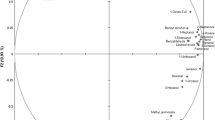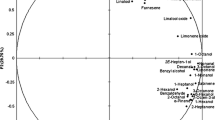Abstract
The plant semiochemical cis-jasmone primes/induces plant resistance that deters herbivores and attracts natural enemies. We studied the induction of volatile organic compounds (VOCs) in winter wheat and spring barley after exposure of plants to three synthetic cis-jasmone doses (50 μl of 1, 100, and 1 × 104 ng μl−1) and durations of exposure (1, 3, and 6 h). Cereal leaf beetle, Oulema melanopus, adult behavioral responses were examined in a Y-tube olfactometer to cis-jasmone induced plant VOC bouquets and to two synthetic blends of VOCs (3 green leaf volatiles (GLVs); 4 terpenes + indole). In both cereals, eight VOCs [(Z)-3-hexanal, (Z)-3-hexanol, (Z)-3-hexanyl acetate, (Z)-β-ocimene, linalool, β-caryophyllene, (E)-ß–farnesene, and indole] were induced 100- to 1000-fold after cis-jasmone exposure. The degree of induction in both cereals was usually positively and linearly associated with increasing exposure dose and duration. However, VOC emission rate was only ~2-fold greater from plants exposed to the highest vs. lowest cis-jasmone exposure doses (1 × 104 difference) or durations (6-fold difference). Male and female O. melanopus were deterred by both cereal VOC bouquets after plant exposure to the high cis-jasmone dose (1 × 104 ng μl−1), while females were also deterred after plant exposure to the low dose (1 ng μl−1) but attracted to unexposed plant VOC bouquets. Both O. melanopus sexes were repelled by terpene/indole and GLV blends at two concentrations (25 ng · min−1; 125 ng · min−1), but attracted to the lowest dose (1 ng · min−1) of a GLV blend. It is possible that the biologically relevant low cis-jasmone dose has ecological activity and potential for inducing field crop VOCs to deter O. melanopus.


Similar content being viewed by others
References
Birkett, M. A., Campbell, C. A. M., Chamberlain, K., Guerrieri, E., Hick, A. J., Martin, J. L., Matthes, M., Napier, J. A., Pettersson, J., Pickett, J. A., Poppy, G. M., Pow, E. M., Pye, B. J., Smart, L. E., Wadhams, G. H., Wadhams, L. J., and Woodcock, C. M. 2000. New roles for cis-jasmone as an insect semiochemical and in plant defense. Proc. Natl. Acad. Sci. USA 97:9329–9334.
Bruce, T. J. A., Martin, J. L., Pickett, J. A., Pye, B. J., Smart, L. E., and Wadhams, L. J. 2003. Cis-Jasmone treatment induces resistance in wheat plants against the grain aphid, Sitobion avenae (Fabricius) (Homoptera: Aphididae). Pest. Manag. Sci. 59:1031–1036.
Bruce, T. J. A., Matthes, M. C., Chamberlain, K., Woodcock, C. M., Mohib, A., Webster, B., Smart, L. E., Birkett, M. A., Pickett, J. A., and Napier, J. A. 2008. Cis-jasmone induces Arabidopsis genes that affect the chemical ecology of multitrophic interactions with aphids and their parasitoids. Proc. Natl. Acad. Sci. USA 105:4553–4558.
Bruce, T. J. A. and Pickett, J. A. 2007. Plant defence signalling induced by below and above-ground attacks. Curr. Opin. Plant Biol. 10:387–392.
Bruce, T. J. A. and Pickett, J. A. 2011. Perception of plant volatile blends by herbivorous insects - Finding the right mix. Phytochemistry 72:1605–1611.
Carroll, M. J., Schmelz, E. A., Meagher, R. L., and Teal, P. E. A. 2006. Attraction of Spodoptera frugiperda larvae to volatiles from herbivore-damaged maize seedlings. J. Chem. Ecol. 32:1911–1924.
Chamberlain, K., Pickett, J. A., and Woodcock, C. M. 2000. Plant signaling and induced defense in insect attack. Mol. Plant Pathol. 1:67–72.
Conrath, U., Beckers, G. J. M., Flors, V., García-Agustí, N. P., Jakab, G., Mauch, F., Newman, M. A., Pieterse, C. M. J., Poinssot, B., Pozo, M. J., Pugin, A., Schaffrath, U., Ton, J., Wendehenne, D., Zimmerli, L., and Mauch-Mani, B. 2006. Priming: getting ready for battle. Mol. Plant-Microbe Interact. 19:1062–1071.
Dicke, M. and Baldwin, I. T. 2010. The evolutionary context for herbivore-induced plant volatiles: beyond the ‘cry for help’. Trends Plant Sci. 15:167–174.
Dicke, M., van Loop, J. J. A., and Soler, R. 2009. Chemical complexity of volatiles from plants induced by multiple attack. Nat. Chem. Biol. 5:317–324.
Dimitrijević, B., Jelić, M., and Lomović, S. 1999. The effect of mineral nutrition on the damage degree of spring wheat by Lema melanopus L. (Coleoptera: Chrysomelidae). Acta Entomol Serbica 4:49–55.
El-Sayed, A. M., Mitchell, V. J., McLaren, G. F., Manning, L. M., Bunn, B., and Suckling, D. M. 2009. Attraction of New Zealand Flower Thrips, Thrips obscuratus, to cis-jasmone, a volatile identified from Japanese honeysuckle flowers. J. Chem. Ecol. 35:656–63.
Engelberth, J., Alborn, H. T., Schmelz, E. A., and Tumlinson, J. H. 2004. Airborne signals prime plants against insect herbivore attack. Proc. Natl. Acad. Sci. USA 101:1781–1785.
Farag, M. A., Fokar, M., Abd, H., Zhang, H., Allen, R. D., and Paré, P. W. 2005. (Z)-3-hexenol induces defense genes and downstream metabolites in maize. Planta 220:900–909.
Farag, M. A. and Paré, P. W. 2002. C6-green leaf volatiles trigger local and systemic VOC emissions in tomato. Phytochemistry 61:545–554.
Farmer, E. E. and Ryan, C. A. 1990. Interplant communication: airborne methyl jasmonate induces synthesis of proteinase inhibitors in plant leaves. Proc. Natl. Acad. Sci. USA 87:7713–7716.
Frost, C. J., Appel, H. M., Carlson, J. E., De Moraes, C. M., Mescher, M. C., and Schultz, J. C. 2007. Within-plant signalling via volatiles overcomes vascular constraints on systemic signalling and primes responses against herbivores. Ecol. Lett. 10:490–498.
Hare, J. D. 2011. Ecological role of volatiles produced by plants in response to damage by herbivorous insects. Annu. Rev. Entomol. 56:161–180.
Kessler, A. and Baldwin, I. T. 2001. Defensive function of herbivore-induced plant volatile emissions in nature. Science 291:2141–2144.
Kessler, A., Halitschke, R., Diezel, C., and Baldwin, I. T. 2006. Priming of plant defense responses in nature by airborne signaling between Artemisia tridentata and Nicotiana attenuata. Oecologia 148:280–292.
Koch, T., Bandemer, K., and Boland, W. 1997. Biosynthesis of cis-jasmone: a pathway for the inactivation and the disposal of the plant stress hormone jasmonic acid to the gas phase? Helv. Chim. Acta 80:838–850.
Loughrin, J. H., Manukian, A., Heath, R. R., and Tumlinson, J. H. 1995. Volatiles emitted by different cotton varieties damaged by feeding beet armyworm larvae. J. Chem. Ecol. 21:1217–1227.
Loughrin, J. H., Manukian, A., Heath, R. R., Turlings, T. C. J., and Tumlinson, J. H. 1994. Diurnal cycle of emission of induced volatile terpenoids by herbivore-injured cotton plants. Proc. Natl. Acad. Sci. USA 91:11836–11840.
Matthes, M. C., Bruce, T. J. A., Ton, J., Verrier, P. J., Pickett, J. A., and Napier, J. A. 2010. The transcriptome of cis-jasmone induced resistance in Arabidopsis thaliana and its role in indirect defense. Planta 232:1163–80.
Moraes, M. C. B., Birkett, M. A., Gordon-Weeks, R., Smart, L. E., Martin, J. L., Pye, B. J., Bromilow, R., and Pickett, J. A. 2008. Cis-Jasmone induces accumulation of defence compounds in wheat, Triticum aestivum. Phytochemistry 69:9–17.
Pickett, J. A., Birkett, M. A., Bruce, T. J. A., Chamberlain, K., Gordon-Weeks, R., Matthes, M. C., Napier, J. A., Smart, L. E., and Woodcock, C. M. 2007a. Developments in aspects of ecological phytochemistry: the role of cis-jasmone in inducible defence systems in plants. Phytochemistry 68:2937–2945.
Pickett, J. A. and Poppy, G. M. 2001. Switching on plant genes by external chemical signals. Trends Plant Sci. 6:137–139.
Pickett, S. T. A., Kolasa, J., and Jones, C. 2007b. Ecological understanding: the nature of theory and the theory of nature, 2nd ed. Academic, Boston.
Piesik, D., Łyszczarz, A., Tabaka, P., Lamparski, R., Bocianowski, J., and Delaney, K. J. 2010a. Volatile induction of three cereals: influence of mechanical injury and insect herbivory on injured plants and neighboring uninjured plants. Ann. Appl. Biol. 157:425–434.
Piesik, D., Lemańczyk, G., Skoczek, A., Lamparski, R., Bocianowski, J., Kotwica, K., and Delaney, K. J. 2011a. Fusarium infection in maize: Volatile induction of infected and neighboring uninfected plants has the potential to attract a pest cereal leaf beetle, Oulema melanopus. J. Plant Physiol. 168:1534–1542.
Piesik, D., Pańka, D., Delaney, K. J., Skoczek, A., Lamparski, R., and Weaver, D. K. 2011b. Cereal crop volatile organic compound induction after mechanical injury, beetle herbivory (Oulema spp.), or fungal infection (Fusarium spp.). J Plant Physiol 168:878–886.
Piesik, D., Pańka, D., Jeske, M., Wenda-Piesik, A., Delaney, K. J., and Weaver, D. K. 2013. Volatile induction of infected (Fusarium spp.) and neighboring uninfected barley and wheat may influence attraction/repellence of a cereal herbivore. J. Appl. Entomol. doi:10.1111/j.1439-0418.2012.01742.x.
Piesik, D., Weaver, D. K., Runyon, J. B., Buteler, M., Peck, G. E., and Morrill, W. L. 2008. Behavioral responses of wheat stem sawflies to wheat volatiles. Agric. For. Entomol. 10:245–253.
Piesik, D., Wenda-Piesik, A., Lamparski, R., Tabaka, P., Ligor, T., and Buszewski, B. 2010b. Effects of mechanical injury and insect feeding on volatiles emitted by wheat plants. Entomol. Fennica 21:117–128.
Phillips, C. R., Herbert, D. A., Kuhar, T. P., Thomason, W. E., and Malone, S. 2011. Fifty years of cereal leaf beetle in the U.S.: an update on its biology, management, and current research. J. Integr Pest Manag 2:1–5. doi:10.1603/IPM11014.
Röse, U. S. R. and Tumlinson, T. H. 2004. Volatiles released from cotton plants in response to Helicoverpa zea feeding damage on cotton flower buds. Planta 218:824–832.
Röse, U. S. R. and Tumlinson, T. H. 2005. Systemic release of volatile induction in cotton: how specific is the signal to herbivory? Planta 222:327–335.
Schlotzhauer, W. S., Pair, S. D., and Horvart, R. J. 1996. Volatile constituents from flowers of Japanese Honeysuckle (Lonicera japonica). J. Agr. Food. Chem. 44:206–209.
Schoonhoven, L. M., Van Loon, J. J. A., and Dicke, M. 2005. Insect-plant biology. Oxford University Press, UK.
Tanaka, K., Uda, Y., Ono, Y., Nakagawa, T., Suwa, M., Yamaoka, R., and Touhara, K. 2009. Highly selective tuning of a silkworm olfactory receptor to a key mulberry leaf volatile. Curr Biol 19:881–90.
Tasin, M., Bäckman, A.-C., Coracini, M., Casado, D., Ioriatti, C., and Witzgall, P. 2007. Synergism and redundancy in a plant volatile blend attracting grapevine moth females. Phytochemistry 68:203–209.
Thaler, J. S., Stout, M. J., Karban, R., and Duffey, S. S. 1996. Exogenous jasmonates simulate insect wounding in tomato plants (Lycopersicon esculentum) in the laboratory and field. J. Chem. Ecol. 22:1767–1781.
Thaler, J. S., Karban, R., Ullman, D. E., Boege, K., and Bostock, R. M. 2002. Cross-talk between jasmonate and salicylate plant defense pathways: effects on several plant parasites. Oecologia 131:227–235.
Turlings, T. C. J., Tumlinson, J. H., and Lewis, W. J. 1990. Exploitation of herbivore-induced plant odors by host-seeking parasitic wasps. Science 250:1251–1253.
Acknowledgments
We thank R.B. Srygley for performing the ARS paper review, as well as two anonymous reviewers for providing comments that improved previous drafts of this manuscript. This research was partly supported with funds provided by the Ministry of Science and Higher Education (contract number 1648/B/P01/2010/39 entitled, ‘Effect of volatile organic compounds released by green and floral parts of Brassica napus on behavior of Meligethes aeneus F.
Author information
Authors and Affiliations
Corresponding author
Rights and permissions
About this article
Cite this article
Delaney, K.J., Wawrzyniak, M., Lemańczyk, G. et al. Synthetic Cis-Jasmone Exposure Induces Wheat and Barley Volatiles that Repel the Pest Cereal Leaf Beetle, Oulema melanopus L.. J Chem Ecol 39, 620–629 (2013). https://doi.org/10.1007/s10886-013-0281-4
Received:
Revised:
Accepted:
Published:
Issue Date:
DOI: https://doi.org/10.1007/s10886-013-0281-4




